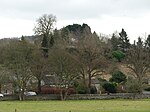Bakewell railway station
1862 establishments in EnglandBakewellDisused railway stations in DerbyshireEdward Walters railway stationsFormer Midland Railway stations ... and 5 more
Grade II listed buildings in DerbyshirePages with no open date in Infobox stationRailway stations in Great Britain closed in 1967Railway stations in Great Britain opened in 1862Use British English from March 2015

Bakewell railway station was a railway station built to serve the town of Bakewell in Derbyshire, England, by the Midland Railway on its extension of the Manchester, Buxton, Matlock and Midland Junction Railway line from Rowsley to Buxton.
Excerpt from the Wikipedia article Bakewell railway station (License: CC BY-SA 3.0, Authors, Images).Bakewell railway station
Station Road, Derbyshire Dales
Geographical coordinates (GPS) Address Nearby Places Show on map
Geographical coordinates (GPS)
| Latitude | Longitude |
|---|---|
| N 53.2177 ° | E -1.6689 ° |
Address
Station Road
Station Road
DE45 1GE Derbyshire Dales
England, United Kingdom
Open on Google Maps











